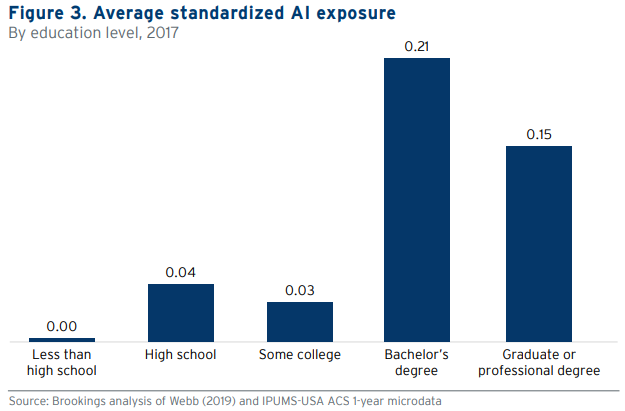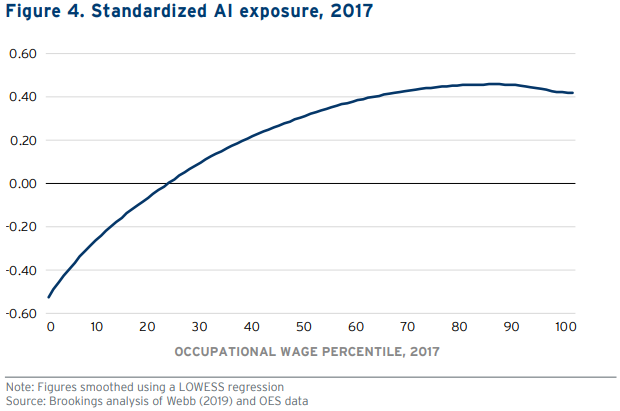
The story about jobs lost to automation has always focused on how the workers hardest hit by the brave new world will be those whose jobs are at risk from improved robotics and better software. That story is true, but it’s not the only story.
Those Americans in occupations that do not require a college degree are more at risk than those with college degrees to be replaced by automation in the near future — more than twice as likely, according to a Brookings Institution study published last January.
In the Brookings study and others like it, automation has been used as a catchall term to identify technologies including robotics, software and artificial intelligence (AI). But thinking of automation technologies as those that involve rules-based tasks and AI as those that require a machine that can learn, think and act independently, the difference between automation and AI comes into focus.
Leaving automation to one side, then, will AI have an impact on occupations that generally require more education and pay higher wages? According to a new study from Brookings, “AI has a distinctly white-collar bent” and “white-collar, well-paid America—radiologists, legal professionals, optometrists, and many more—will likely get no free pass on this flavor of digital disruption.”
Using a method developed by Stanford University Ph.D. candidate Michael Webb, Brookings analyzed occupations that are more likely to be affected by AI. Webb’s method involved searching the text of patent applications to identify AI capabilities and then to compare those capabilities to job descriptions to find places where the two overlap. That overlap was then converted into a measure of an occupation’s exposure to the risk of being replaced by AI. The exposure scores were normalized with a mean of zero and reported as a “standardized AI exposure” score.
While not all occupations face major job losses, Webb’s data indicates that the statistical reach of AI will affect virtually every segment of the labor market. The following chart shows the average standardized AI exposure based on educational level. Higher numbers indicate higher risk from AI technologies. AI is just one of the technologies poised to change the way we live.
The next chart indicates standardized AI exposure based on occupational wages. Again, higher numbers indicate higher risk. However, once the curve reaches the 90th percentile, the exposure flattens out. The Brookings researchers note: “[W]hile middle- and upper-middle-class workers are likely to be impacted by artificial intelligence, the most elite workers—such as CEOs—appear to be somewhat protected.”
The industrial sector with the highest standardized AI exposure is, perhaps surprisingly, agriculture, forestry, fishing and hunting. Farming, however, may be turning to AI more quickly than any other industry. AI technologies are already helping the ag industry improve crop yields, control pests and monitor soil conditions, among other things. The industry’s standardized AI exposure is 1.21. Other industries with high exposure scores are utilities (0.73), manufacturing (0.61), mining and extraction (0.50), professional scientific and technical services (0.47) and information (0.44).
The following map indicates which U.S. metropolitan areas are most exposed to AI technologies. Brookings’ analysts note that the geographic analysis “reveals that smaller, more rural communities are significantly less exposed to technological disruption than larger, dense urban ones. This likely reflects the basic urban geography of the information, technology, and professional-managerial economy, with its orientation toward analytics, prediction, and strategy—all susceptible to AI solutions. Similarly, bigger, tech-focused metro areas and manufacturing hubs dominate the list of highly exposed larger places, and the full list of exposed metro areas displays a number of smaller manufacturing or agricultural places as well.”
Here are the 15 cities with the highest standardized AI exposure scores, according to the Brookings analysis. Included is the standardized AI exposure for the metro area and the total number of jobs, along with jobs in BLS occupation codes for computer/math (AI exposure score of 1.04), health care practitioners (0.26) and management (0.25). All these metros have scores of at least 0.5 and are represented by red circles on the map. The bigger the circle, the higher the risk from AI.
San Jose-Sunnyvale-Santa Clara, California
> Standardized AI exposure: 0.20
> Total jobs: 1.12 million
> Computer/math jobs: 141,030
> Management jobs: 92,430
> Health care practitioners: 45,320
Bakersfield, California
> Standardized AI exposure: 0.19
> Total jobs: 307,220
> Computer/math jobs: 4,040
> Management jobs: 11,480
> Health care practitioners: 14,810
Greenville-Anderson-Mauldin, South Carolina
> Standardized AI exposure: 0.14
> Total jobs: 413,300
> Computer/math jobs: 8,170
> Management jobs: 18,610
> Health care practitioners: 25,970
Grand Rapids-Wyoming, Michigan
> Standardized AI exposure: 0.11
> Total jobs: 567,840
> Computer/math jobs: 10,030
> Management jobs: 24,520
> Health care practitioners: 35.010
Seattle-Tacoma-Bellevue, Washington
> Standardized AI exposure: 0.10
> Total jobs: 1.98 million
> Computer/math jobs: 139,440
> Management jobs: 110,930
> Health care practitioners: 95,330
Detroit-Warren-Dearborn, Michigan
> Standardized AI exposure: 0.10
> Total jobs: 1.97 million
> Computer/math jobs: 71,350
> Management jobs: 96,510
> Health care practitioners: 127,170
Louisville/Jefferson County, Kentucky-Indiana
> Standardized AI exposure: 0.08
> Total jobs: 952,100
> Computer/math jobs: 16,760
> Management jobs: 31,180
> Health care practitioners: 40,310
Salt Lake City, Utah
> Standardized AI exposure: 0.08
> Total jobs: 713,060
> Computer/math jobs: 29,790
> Management jobs: 55,310
> Health care practitioners: 36,720
Greensboro-High Point, North Carolina
> Standardized AI exposure: 0.07
> Total jobs: 361,150
> Computer/math jobs: 7,300
> Management jobs: 15,160
> Health care practitioners: 18,740
Ogden-Clearfield, Utah
> Standardized AI exposure: 0.06
> Total jobs: 254,400
> Computer/math jobs: 6,890
> Management jobs: 15,000
> Health care practitioners: 11,540
Nashville-Davidson-Murfreesboro-Franklin, Tennessee
> Standardized AI exposure: 0.05
> Total jobs: 968,600
> Computer/math jobs: 25,680
> Management jobs: 64,670
> Health care practitioners: 63,470
Durham-Chapel Hill, North Carolina
> Standardized AI exposure: 0.05
> Total jobs: 308,480
> Computer/math jobs: 19,640
> Management jobs: 18,960
> Health care practitioners: 30,990
Indianapolis-Carmel-Anderson, Indiana
> Standardized AI exposure: 0.05
> Total jobs: 1.04 million
> Computer/math jobs: 33,610
> Management jobs: 58,040
> Health care practitioners: 74,760
Atlanta-Sandy Springs-Roswell, Georgia
> Standardized AI exposure: 0.05
> Total jobs: 2.68 million
> Computer/math jobs: 123,340
> Management jobs: 176,370
> Health care practitioners: 139,190
Charlotte-Concord-Gastonia, North Carolina-South Carolina
> Standardized AI exposure: 0.05
> Total jobs: 1.21 million
> Computer/math jobs: 58,570
> Management jobs: 63,700
> Health care practitioners: 61,490
Want to Retire Early? Start Here (Sponsor)
Want retirement to come a few years earlier than you’d planned? Or are you ready to retire now, but want an extra set of eyes on your finances?
Now you can speak with up to 3 financial experts in your area for FREE. By simply clicking here you can begin to match with financial professionals who can help you build your plan to retire early. And the best part? The first conversation with them is free.
Click here to match with up to 3 financial pros who would be excited to help you make financial decisions.
Have questions about retirement or personal finance? Email us at [email protected]!
By emailing your questions to 24/7 Wall St., you agree to have them published anonymously on a673b.bigscoots-temp.com.
By submitting your story, you understand and agree that we may use your story, or versions of it, in all media and platforms, including via third parties.
Thank you for reading! Have some feedback for us?
Contact the 24/7 Wall St. editorial team.





